
16, July 2025
Find Nostalgia in Nature with Flower Folklore
Plants have inspired myths and legends for millennia. Perhaps the most enduring of these are the children’s rhymes, rituals and games that were made in meadows and passed down through generations. While today's children might be more drawn to phones than flora, certain flower folklore is still thriving – proving there’s still a connection between Nature and play. You don't have to be a child to enjoy these rituals, so head outside and enjoy some nostalgia in Nature!
Buttercups

Do you like butter (or plant-based alternatives)? Hold a buttercup under someone’s skin to find out. A yellow reflection on the skin is said to be proof the person likes butter. Of course, thanks to buttercups’ glossy petals, most people get the tell-tale yellow glow – especially on a bright, sunny day. Even if they don’t like butter. Or are a vegan.
Scientists researched what makes buttercups so bright and shiny. It’s to do with the unique and very rare structure of the petals, designed to attract pollinators.
The buttercup game may have come from the historical belief that eating buttercups made cows produce richer milk (it’s now known that the plant is toxic to cows). References to the game appear in Victorian children’s literature, but it’s thought it originated much earlier.
Daisies

“He loves me, he loves me not…” – so goes the rhyme recited while plucking daisy petals to reveal a love interest’s feelings. The French version, effeuiller la marguerite (stripping the daisy), is a little more nuanced. It lists levels of love: a little, a lot, passionately, madly, or not at all.
In Roman, Greek and Norse mythology, daisies were associated with innocence, beauty and devotion, which is probably why they ended up being used in this game. That and the fact they have plenty of petals (up to 30!), making them perfect for plucking.
The daisy’s name is thought come from the phrase ‘day’s eye’, because it opens at sunrise and closes at sunset. But like many plants steeped in folklore, it goes by lots of other titles. ‘Bruisewort’ stems from the belief the flowers could soothe bumps and swellings. And the Scottish ‘bairnwort’ translates literally to ‘children’s plant’ – perhaps because it was so loved for making daisy chains (another dose of natural nostalgia!).
Dandelions

Remember ‘telling the time’ by blowing the seeds of a dandelion clock? This game is likely linked to the dandelion’s association with time. The flowers open in the morning and close in the afternoon or dull weather, so historically they’ve been used as clocks and barometers.
Dandelion seeds were also blown away in the belief that they could grant wishes, send messages to loved ones and even reveal how many children a person would have.
One dandelion myth is less romantic. For centuries, children have told each other that touching dandelions causes bed-wetting. At one point, the plant was even known as ‘wet-the-bed’. This is probably because dandelion tea is a diuretic that was used in herbal medicine to cleanse kidneys. ‘Scary’ urban (or rural!) myths like this may have been started deliberately to discourage children from touching plants. Some think herbalists did this to protect their precious resources, while others believe it was to remind children of the potency of plants, protecting them from poisonous species.
Clover

The four-leaf clover is considered lucky because it’s so hard to find. A 2017 survey called ‘Share the Luck’ suggested the genetic anomaly occurs in 1 in 5000 clovers. Pretty rare – but not as rare as this 63-leaf one.
In Celtic and medieval folklore, four-leaf clovers were believed to ward off witches, curses and evil spirits. They also had a reputation for revealing fairies, which continued into the 19th century, inspiring children to hunt for them. Like many talismans, four-leaf clovers were also linked to love; people placed them under pillows, over doors and even in shoes in the belief they’d lead them to their soulmate.
Never been lucky enough to find a four-leaf clover? Some people are experts, like record-breaking Gabriell Gerhardt, who has amassed a collection of 118,791. While Gerhardt isn’t sharing her secrets, guides like this might just give you a chance. If nothing else, searching for four-leaf clovers is a wonderful way to spend a warm day – and connect with Nature.
If you enjoyed this, you might like:
The Wonder of Weeds: Nature’s Unsung Heroes



